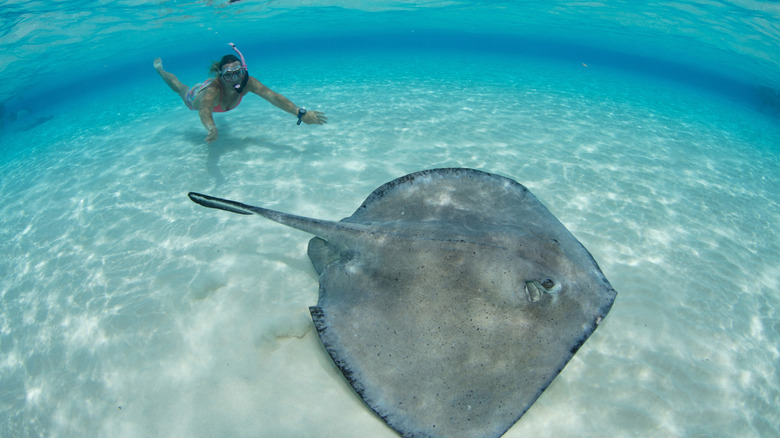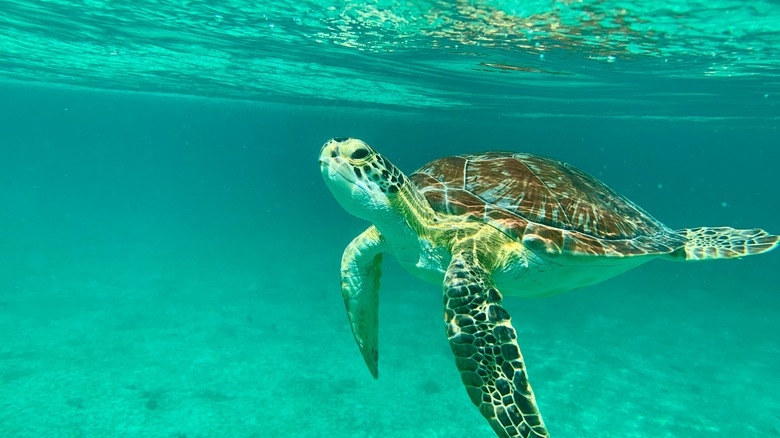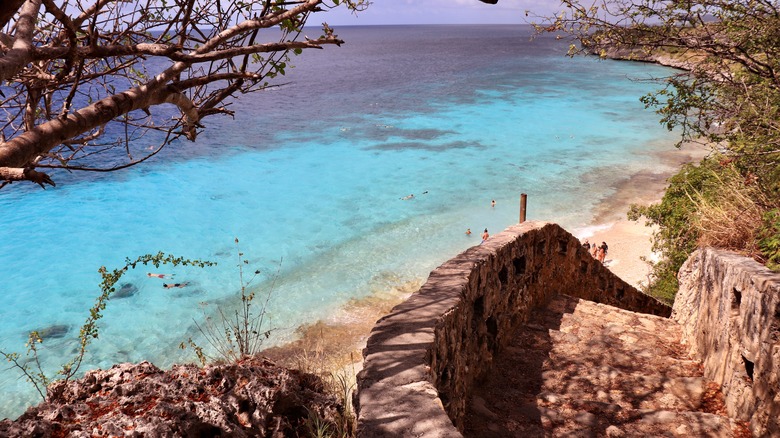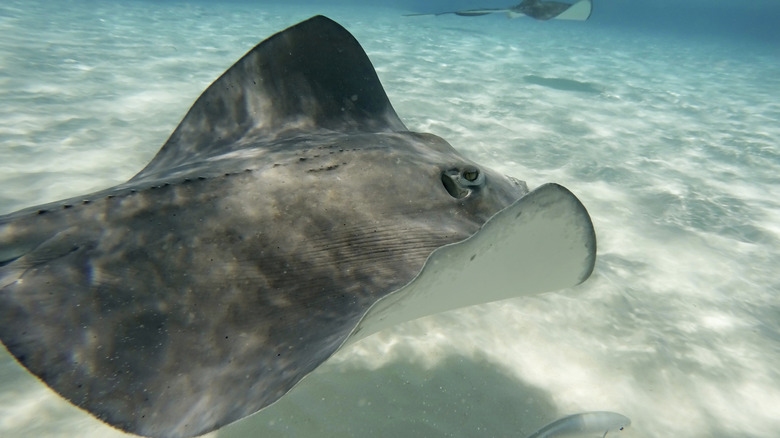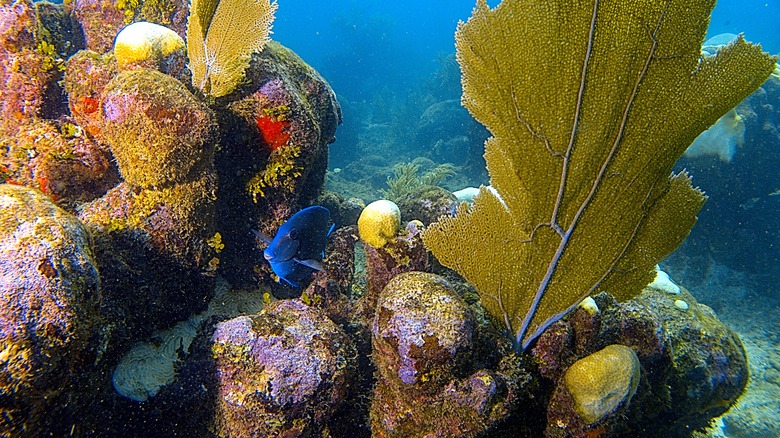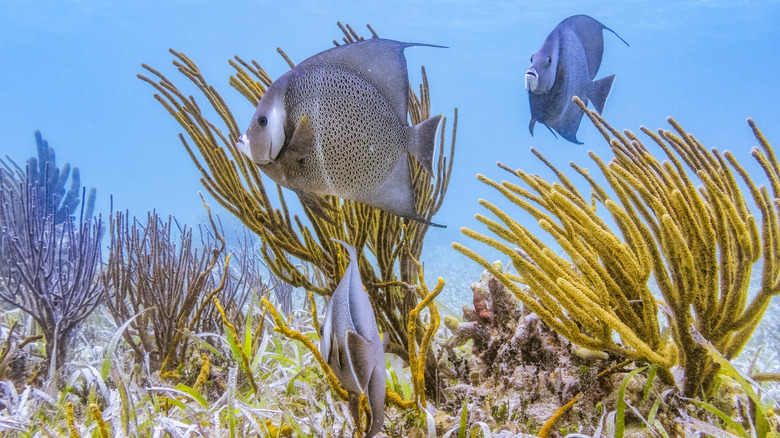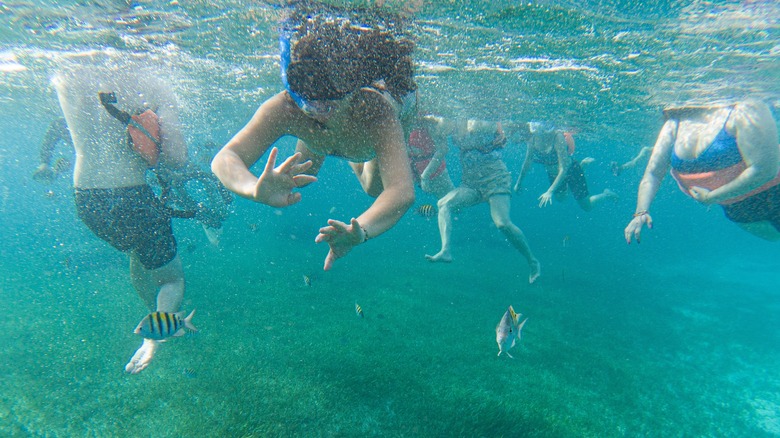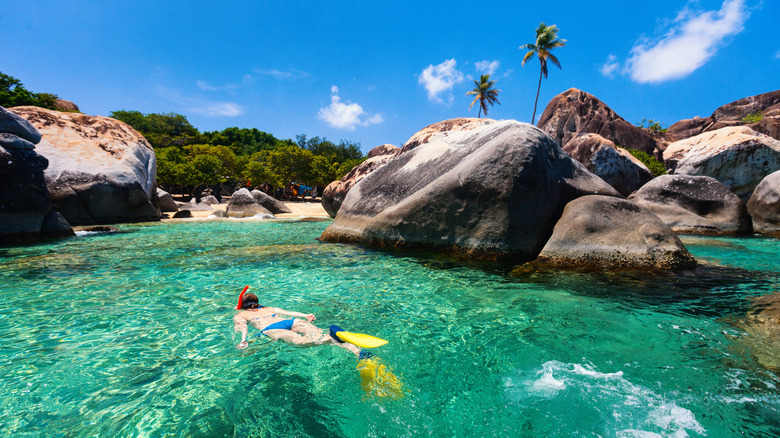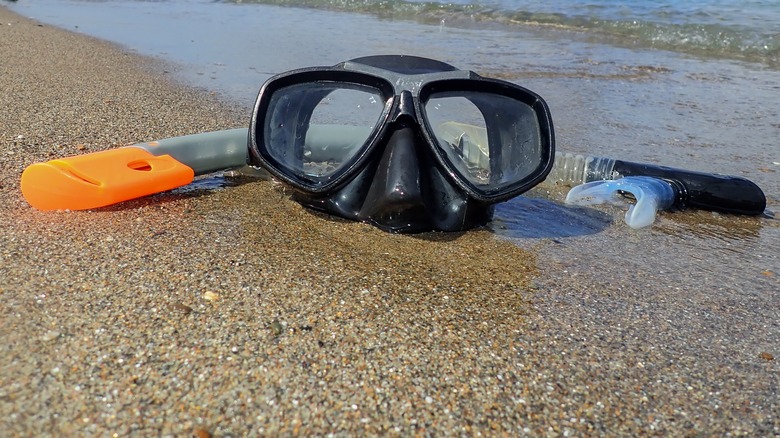Which Caribbean Islands Are Best For Your Snorkeling Skills?
Snorkeling off the coast of the many stunning Caribbean islands means swimming through turtle-filled seagrass in waist-deep water or navigating long swims out to reef walls that drop deep into the blue. It all depends on where you go, and tackling some sites depends on your snorkeling ability.
Thankfully, beginners have an abundance of excellent sites to choose from. Some are so easy that you can just walk out from the beach and marvel at the kaleidoscopic schools of tropical fish and coral within minutes. Others require a bit more effort and are more suitable for intermediate to advanced snorkelers who are more confident in the water. These sites can offer more variety, from wrecks covered in coral and sponges to mysterious caves, and the stronger currents can bring in bigger marine life.
We have consulted travelers and forums to discover the most popular Caribbean islands for snorkeling and leaned on authoritative sources to gauge the required skill levels to take them on. So, let's discover the Caribbean islands best suited to your snorkeling ability.
St. John, United States Virgin Islands: Beginner to intermediate
St. John isn't just a verdant paradise with one of the world's best beaches, it's also a legit snorkeler's eden suitable for all skill levels. Calm bays, turtle hotspots, and mesmerizing reefs make it a place where you could spend an entire vacation just floating on the surface, looking down into the technicolor terrain. Maho Bay is one of the best sites for beginners. You'll spot green sea turtles hanging out in the shallow seagrass and the occasional ray or friendly nurse shark if you're lucky. Visibility is clear, and the calm, shallow waters and easy beach access make it ideal for novices. The low current and gentle depth of Trunk Bay are also ideal for those new to the sport. It's also famous for its underwater snorkel trail of illustrated plaques that guide you past fish and coral with interesting facts.
The easily accessible reefs of Hawksnest Bay and Haulover South, where you might spot lobsters and even the odd octopus, have varying swells and currents that start to take us into intermediate territory. If you want something a little wilder, Leinster Bay and Waterlemon Cay offer deeper reefs with sea fans and star coral with blue chromis darting through the drop-offs. Just stick to the southern side, as the north can get a bit rough. Intermediates will also enjoy Salt Pond Bay and the neighboring Blue Cobblestone Beach, which both serve up a bit more of a challenge with deeper reefs and seas that are a little more on the choppy side.
Bonaire, Caribbean Netherlands: Beginner to intermediate
Bonaire, in the Caribbean Netherlands, is a wildly underrated tropical paradise. Its calm seas, warm waters, and easy reef access just steps from the sand also make it one of the easiest islands in the Caribbean to just throw on a mask and hit the water. Sorobon Beach in Lac Bay is one of the first sites that beginners will want to explore. The water is shallow, and there's almost no current. Here you'll find soft corals, colorful reef fish, and the occasional turtle cruising through. Closer to town, you'll find Te Amo Beach. It's every bit as easy, and you can expect to see parrotfish, angelfish, and big schools of silvery baitfish shimmering in the sun.
However, there are some spots that novices may wish to leave to the intermediates. At 1000 Steps, snorkelers must trek down a limestone staircase to get to the water. Combined with its more challenging depths, this one could be considered more suitable for intermediates, although it still isn't particularly difficult. Salt Pier is used to load salt onto cargo ships from nearby evaporation ponds. It may be a little industrial-looking, but once under the surface, you're treated to a kaleidoscope of fish chewing on coral and algae on the pier's pilings. It is deeper here and a little more exposed, so it's more suitable for intermediates. However, the payoff is spotting rays, needlefish, and large schools of snapper swirling around the coral-covered columns. Finally, at Klein Bonaire, there's an uninhabited islet that everybody raves about. Here, you'll drift over soft coral gardens, sea turtles, and maybe even a manta ray or two if the luck gods are shining on you.
Curaçao, Caribbean Netherlands: Beginner to intermediate
With warm, turquoise waters and reefs so close to the shore that you could probably swim to them with a margarita in hand, the coastal wonderland of Curaçao has a reef system practically begging beginners to snorkel it. Tugboat Beach is the iconic spot. As you might have guessed, a sunken tugboat sits under the water. It's covered in sponges and coral and surrounded by wrasse, angelfish, and the occasional moray eel. The swim is short and the water shallow, meaning it sits at a level suitable for beginners.
Other excellent sites for the novice include The Wall and The Garden at Blue Bay Beach. This one is a gentle swim with calm surf and great visibility. The fortunate will spot an octopus here, while garden eels poke up from the sand and trumpetfish camouflage themselves in the coral while they wait to feed. Cas Abao Beach offers superb shore snorkeling. With its soft sand and easy reef access, it's a great place to spend the day topping up your tan and cooling down in easy waters among colorful fish and coral.
The deeper depths and longer swim of Playa Kalki, aka Alice in Wonderland, may put off some beginners, but the calm currents make it safe for most swimmers. With a sloping reef wall full of neon colors, it lives up to its name, too. However, there is one area for intermediates. Klein Curaçao requires a boat ride, and the currents can shift around the island, so it's best for strong swimmers or those with a guide. But with vivid coral, huge visibility, and practically guaranteed sightings of turtles, the payoff is spectacular.
Grand Cayman, Cayman Islands: Beginner to advanced
Grand Cayman hands coral cruisers of all skill levels one of the Caribbean's most varied snorkeling menus on a plate. While it's mostly beginner-friendly, there are a few bolder sites for those who like to push things further. Cemetery Reef is one of the top picks for novices. Swim out about 200 yards, and you'll find coral towers teeming with fish. Another low-difficulty site is Smith's Barcadere, which offers a mix of coral heads and dramatic shoreline with still, shallow waters. However, Stingray City is the headline act. Here, you'll swim in shallow waters while southern stingrays brush past looking for food. It's accessible by boat, but once there, zero effort is required.
Intermediates don't need to leave George Town, the capital city, to find good snorkeling. Cheeseburger Reef is as delicious as it sounds, with colorful fish, sandy canyons, and the occasional tarpon. It's close to shore, but since it sits near the harbor, you'll need to keep an eye out for boat traffic, especially when cruise ships are in town. For something a bit more surreal, try Eden Rock and Devil's Grotto for tunnels, overhangs, and summertime swarms of silverside. Kittiwake Wreck is one to reel in the wow factor. This purpose-sunk ship rests in 40 feet of clear water and is packed with sea life. It can be challenging for some due to the depth and access by boat, but once there, it's unforgettable. If you're looking for a real challenge, North Side Reef is an expansive stretch suitable for strong snorkelers with good stamina, thanks to the variable surf and long swim routes. However, you might spot eagle rays, nurse sharks, or even the odd reef squid if you cover enough ground.
Roatán, Honduras: Beginner to intermediate
Situated in the Caribbean Sea, right on the edge of the Mesoamerican Reef, Roatán is the largest of the Bay Islands. But before we go any further, it should be noted that Honduras currently has a Level 3 travel advisory issued by the U.S. Department of State. However, it also notes that "Around resort areas in the Bay Islands, there is a concentration of resources, and these areas are better policed." Canada's travel advisory also states that "The Bay Islands are generally safe."
So, for the undeterred, world-class snorkeling is just steps from the island's soft sands. With calm bays, warm waters, and colors like an underwater Pandora, it's the kind of surreal place that makes you wish you were a dolphin. West Bay Beach is the most popular spot. Within minutes of wading from the shore, you'll be floating above technicolor coral gardens swarming with blue tangs, parrotfish, and the occasional eagle ray. Half Moon Bay is another excellent area for newcomers. This easy-access site hugs a reef wall that's protected from swells, and it's easy to bob on the water while looking down at the abundance of tropical fish weaving their way through the sea fans.
Sandy Bay offers soft coral and barrel sponges, and you may also spot green sea turtles if you're lucky. Swim distances are a little longer, and there are deeper patches of reef. Some coral zones may also be exposed to light currents, so if you're not a confident swimmer, you may want to leave this one to the intermediates. Blue Channel is a deeper, more dynamic spot with its coral canyons and caves, and offers the chance to witness bigger marine life like grouper and spotted eagle rays.
Ambergris Caye, Belize: Beginner to advanced
Belize is another country on the U.S. Department of State's radar, but it should be noted that the Level 3 warning is for Belize City. The rest of the country receives a Level 2. Ambergris Caye is a popular tourist spot, and the U.S. Embassy in Belize states, "Although the majority of reported incidents occur in Belize City, crime may occur anywhere, including tourist destinations such as San Pedro Town (Ambergris Caye)." So, it pays to keep vigilant in Belize. But if you are not put off, visiting Ambergris Caye delivers a snorkeling paradise for all abilities.
The Hol Chan Marine Reserve is an excellent place to start. It's a shallow, protected channel ideal for beginners with its psychedelic coral gardens and regular sightings of sea turtles and moray eels. Another big first step for anyone new to snorkeling is Shark Ray Alley. You'll be floating in shallow waters with gentle nurse sharks and southern stingrays resting and gliding around on the ocean floor. Nurse sharks are not harmful to humans, but make sure you respect their boundaries. Southern stingrays are venomous but non-fatal, and the chances of getting stung are slim to none. The key is to look, but not to touch, while you float above on the calm surface.
Blue Hole takes you into deeper, more open waters. The swims are longer and access is weather-dependent, so it's best left to strong swimmers with open-sea experience. The rewards of swimming there are high, with the 1,000-foot circular reef dropping down 400 feet into a deep cavern. Cruising the wall are queen angelfish, groupers, triggerfish, and spotted moray eels, but it's the sheer scale of the site that leaves its mark.
Providenciales, Turks and Caicos: Beginner to intermediate
The island of Providenciales is where most visitors to the British Overseas Territory of the Turks and Caicos land. It also just happens to be one of the world's most spectacular beach destinations, and where you will find many of the best snorkeling spots in the territory. Grace Bay may get all the adoration above water, but from there, you also get easy access to one of the world's biggest and best barrier reefs. With Bight Reef's walk-in access and warm, clear waters, it's a beginner's paradise and a favorite for beach lovers needing a colorful cool-off spot. Smith's Reef is another standout. It's located near Turtle Cove and is a collection of coral heads, reef walls, and seagrass beds crawling with parrotfish, turtles, butterflyfish, and the odd stingray and barracuda. The entry is a bit rocky, but the reef starts close to shore.
Another excellent site is Malcolm's Road Beach, a remote and less-visited site that packs quite a punch. It drops suddenly into 50 feet of deep water before continuing down into the murky depths. It may be more suitable for intermediate snorkelers, who can enjoy dramatic reef structures and an abundance of swirling marine life. It's also home to the "Thunderdome," a structure built for a 1990s TV game show that was placed underwater as part of a challenge. It was never removed and soon became a unique artificial reef covered in marine growth. However, the U.S. Department of State gives the Turks and Caicos Islands a Level 2 warning and notes that "Most crime occurs in Providenciales." So it pays to stay alert, even in paradise.
Cozumel, Mexico: Beginner to advanced
In Cozumel, the water is warm, the visibility is superb, and the variety of marine life is worth the cost of the flight ticket alone. It sits along the Mesoamerican Barrier Reef and is easily one of the best spots in Mexico for snorkeling addicts. Most of the action takes place on the island's western side, where the waters are calmer and the conditions are easier for beginners. But there are also sites suited to more experienced snorkelers.
Starting with areas with walk-in access, Sky Reef and Money Bar are safe choices. Both are beginner-friendly with calm conditions and are home to parrotfish, eels, sergeant majors, and chromatic coral heads, all very close to shore. Another reliable option for novices is Chankanaab Park. It's a popular spot, but that's because the coral gardens are easy to explore, and there are good chances to spot rays, lobsters, or, if you're very lucky, the rare Cozumel toadfish, aka the splendid toadfish. Novices can also enjoy a unique starfish sanctuary at El Cielo.
Columbia Reef is the premier snorkeling spot on the island. However, the current can be strong and the reef deep, so it may be one for beginners to miss. You'll need a boat to get there, and advanced snorkelers and intermediates who are strong swimmers and comfortable in open water can marvel at stunning coral formations with crystal-clear visibility. The drift will take you by nurse sharks, stingrays, turtles, snappers, and barracuda, among a plethora of colorful reef fish. Another intermediate to advanced site is Playa Casitas, where a small navy patrol boat wreck sits in 20 feet of water. Freedivers will get the most out of this site, while boat traffic and moderate currents mean it is safe for snorkelers of at least an intermediate level.
St. Croix (United States Virgin Islands): Beginner to advanced
St. Croix undeservedly misses out on the attention its siblings, St. Thomas and St. John, often get. However, it quietly offers some of the Caribbean's best snorkeling, with sites from shallow reefs for beginners to wrecks requiring advanced skills. Buck Island is the top draw for beginners. While you can only get there by boat, its guided underwater trail offers easy swimming, shallow coral, and thousands of twisting, twirling tropical fish. The calm waters at Shoys Beach make for another good area for beginners, with patches of seagrass often hiding turtles.
Frederiksted Pier is on the more dynamic side of things. The coral-covered pillars attract octopuses, seahorses, and snappers. Conditions are fairly easy, but the depth drops to 40 feet here, making it more suitable for intermediates, and the site is at its best when there are no ships docked. At Davis Bay, the nearshore cliffs are suitable for beginners, but there is a deeper reef marked by a dive buoy that is best left to more confident swimmers.
Strong swimmers and advanced snorkelers can also experience Cane Bay. There's a steep underwater wall that starts about 600 feet from the shore. It's known for its large marine life, such as turtles, rays, and deepwater fish, but the currents can shift here, so it's one for those with experience. The dual wrecks at Butler Bay are also for advanced snorkelers due to the distance, depth, and occasional current. This swim requires a bit of stamina and planning, but if you're looking for something different, coral and sponges have colonized the wrecks, and they attract reef fish, barracuda, and sometimes eagle rays.
Virgin Gorda (British Virgin Islands): Beginner to advanced
Virgin Gorda is a laid-back Caribbean island surrounded by crystal-clear waters that are perfect for snorkeling. The Baths are the headline act. The granite boulders there tower above the sand and turquoise waters and offer a maze of coral, fish, and the occasional turtle below the surface. The area is shallow and protected, so it's ideal for beginners, while a short swim away is Devil's Bay, where coral gardens attract even more marine life. The visibility here is excellent, and the protected setting keeps the swell down.
On the west of the island, stronger swimmers can tackle Mountain Point. The waters are deeper here, and it's quite remote, so it's best to have a decent level of experience. You'll have the chance to spot nurse sharks cruising the seabed and vibrant coral reefs with a healthy range of tropical fish. However, Virgin Gorda is just one of many excellent snorkeling spots in the British Virgin Islands, and by the time you've gotten through them all, you might want to consider some stunning snorkeling destinations in Asia.
Methodology
We scoured forums on Reddit, Fodor, and TripAdvisor, as well as dedicated snorkeling and diving forums and expert sites like Lonely Planet and SeaVision, to discover the Caribbean islands with the most popular snorkeling sites. We then gauged their difficulty through authoritative sources like websites from national parks and official tourist services, as well as respected tour operators, to keep you informed on where to go and where to avoid.
